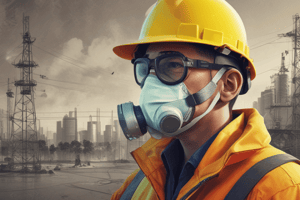Podcast
Questions and Answers
Which of the following is considered Personal Protective Equipment (PPE)? (Select all that apply)
Which of the following is considered Personal Protective Equipment (PPE)? (Select all that apply)
- Steel-toed boots (correct)
- Safety glasses (correct)
- Safety nets
- Hard hats (correct)
Eye protection is essential for guarding against flying debris or chemical splashes.
Eye protection is essential for guarding against flying debris or chemical splashes.
True (A)
What is a Personal Fall Arrest System (PFAS)?
What is a Personal Fall Arrest System (PFAS)?
- Harnesses, lanyards, and anchor points (correct)
- Warning lines for hazard identification
- A system of guardrails
- Safety nets for catching falls
What should be regularly inspected and replaced to ensure safety in construction?
What should be regularly inspected and replaced to ensure safety in construction?
___ are barriers installed around edges of elevated surfaces to prevent falls.
___ are barriers installed around edges of elevated surfaces to prevent falls.
What is one of the leading causes of injuries and fatalities in construction?
What is one of the leading causes of injuries and fatalities in construction?
Match the type of PPE with its description:
Match the type of PPE with its description:
Flashcards are hidden until you start studying
Study Notes
Construction Safety
Personal Protective Equipment (PPE)
-
Definition: Gear designed to protect workers from hazards.
-
Types of PPE:
- Head Protection: Hard hats to prevent head injuries from falling objects.
- Eye Protection: Safety glasses or goggles to guard against flying debris or chemical splashes.
- Hearing Protection: Earplugs or earmuffs to reduce noise exposure in loud environments.
- Respiratory Protection: Masks or respirators to protect against inhaling harmful substances.
- Hand Protection: Gloves suitable for specific tasks (cut-resistant, chemical-resistant).
- Foot Protection: Steel-toed boots to protect against heavy objects and punctures.
- Body Protection: High-visibility clothing and flame-resistant apparel, as needed.
-
Usage Guidelines:
- Conduct a hazard assessment to determine necessary PPE.
- Ensure proper fit and comfort for all workers.
- Provide training on proper use and maintenance of PPE.
- Regularly inspect and replace damaged or worn-out gear.
Fall Protection
-
Importance: Falls are one of the leading causes of injuries and fatalities in construction.
-
Types of Fall Protection:
- Guardrails: Barriers installed around edges of elevated surfaces.
- Safety Nets: Nets used to catch falling workers or materials.
- Personal Fall Arrest Systems (PFAS): Includes harnesses, lanyards, and anchor points to prevent falls.
- Warning Lines: Marked areas alerting workers of fall hazards.
-
Fall Protection Measures:
- Conduct a site assessment to identify potential fall hazards.
- Implement a fall protection plan tailored to the specific site and tasks.
- Train workers on fall hazards and the proper use of fall protection systems.
- Regularly inspect equipment and systems for integrity and compliance.
-
Regulations: Follow OSHA standards for fall protection in construction, including requirements for specific heights and situations.
Personal Protective Equipment (PPE)
- PPE is essential for protecting construction workers from various hazards on-site.
- Types of PPE include:
- Head Protection: Hard hats shield workers from injuries due to falling objects.
- Eye Protection: Safety glasses or goggles defend against debris and chemical splashes.
- Hearing Protection: Earplugs or earmuffs mitigate the risks of noise exposure in high-decibel environments.
- Respiratory Protection: Masks and respirators prevent inhalation of harmful airborne substances.
- Hand Protection: Specialized gloves (cut-resistant or chemical-resistant) safeguard hands while performing specific tasks.
- Foot Protection: Steel-toed boots offer defense against heavy impacts and punctures.
- Body Protection: High-visibility and flame-resistant clothing enhance safety based on operational needs.
- Usage Guidelines for PPE include:
- Conducting hazard assessments to identify required protective gear.
- Ensuring PPE fits properly to maximize comfort and effectiveness.
- Training workers in the correct use and maintenance of their PPE.
- Regular inspection and timely replacement of any damaged or worn equipment.
Fall Protection
- Falls rank among the top causes of injuries and fatalities in the construction industry.
- Types of Fall Protection include:
- Guardrails: Installed barriers that prevent workers from falling off elevated surfaces.
- Safety Nets: Nets positioned below work areas to catch falling personnel or materials.
- Personal Fall Arrest Systems (PFAS): Comprised of harnesses, lanyards, and anchor points to effectively halt a fall.
- Warning Lines: Clearly marked areas to inform workers of fall hazards.
- Fall Protection Measures:
- Conduct thorough site assessments to recognize potential fall risks.
- Develop a fall protection plan customized to the construction site's specific conditions and tasks.
- Provide training for workers on identifying fall hazards and utilizing fall protection systems correctly.
- Schedule regular inspections to ensure equipment and systems remain safe and compliant with standards.
- Regulations include adherence to OSHA standards, which specify requirements for fall protection based on varying heights and scenarios encountered in construction roles.
Studying That Suits You
Use AI to generate personalized quizzes and flashcards to suit your learning preferences.




